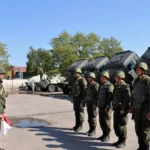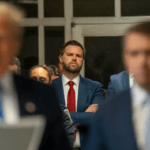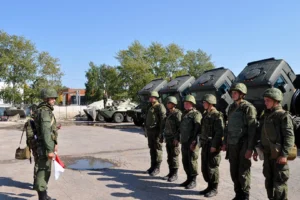MANILA – Growing concerns over China’s military power are resetting geopolitical alignments across the Indo-Pacific in what some see as the dawning of a New Cold War.
At once, two different trilateral alliances are emerging, both built around America’s “integrated deterrence” strategy amid intensified fears of a Chinese invasion of Taiwan in the near-term future.
On one hand, the US, UK and Australia have taken a fateful step in their AUKUS alliance by greenlighting the production of a new fleet of nuclear-powered submarines, drawing on cutting-edge Rolls-Royce nuclear reactors.
In the next five years, the US and UK are also expected to station nuclear submarines in the Western Australian capital of Perth, while Canberra is slated to purchase several US-made Virginia-class submarines over the next decade.
The AUKUS submarine deal allows the three anglophone allies to project power across the region, especially in the contested waters across the so-called First Island Chain, which extends from the East China Sea to the Taiwan Strait and all the way across the South China Sea.
Meanwhile, there is a burgeoning Japan-Philippines-US (JAPHUS) trilateral alliance in the making with similar strategic objectives and even greater geographic immediacy. The upshot is a fast-emerging tripartite defense framework, which will be indispensable to an effective deterrence strategy against China over Taiwan and the broader First Island Chain theater.
Both Japan and the Philippines, Taiwan’s most immediate neighbors, are undergoing foreign policy revolutions.
For its part, Tokyo is recasting its post-World War II pacifist foreign policy by embracing a more proactive strategic role in the region. Japan is now contemplating the prospect of exporting sophisticated weapons systems to besieged nations, notably Ukraine. The move, however, also has direct implications for Taiwan, which is facing the growing prospect of armed confrontation with China.
Meanwhile, Manila had tilted back to traditional allies following the departure of Beijing-leaning president Rodrigo Duterte last year. Under Ferdinand Marcos Jr, the Southeast Asian country has become a core element of a new trilateral grouping, JAPHUS, which will be indispensable to deterring any potential Chinese invasion of Taiwan.
Self-governing Taiwan, which is treated as a renegade province by Beijing, is simultaneously central to both regional security architecture as well as economic integration. The world’s most sophisticated processor chips are made largely by a single Taiwanese company, Taiwan Semiconductor Manufacturing Company Limited (TSMC).
Taiwan’s chips are as important to the 21st-century global economy as the Organization of Petroleum Exporting Countries (OPEC) was to the previous century. But as political scientist Chris Miller explains, what makes Taiwan even more critical is that “[u]nlike oil, which can be bought from many countries, our production of computing power” depends on a few producers, especially those in Taiwan.
Beijing has stepped up its threats to Taiwan in recent years, especially following former US Speaker of the House Nancy Pelosi’s visit to the island, which sparked unprecedented Chinese wargames in adjacent waters.
A year earlier, Admiral Philip Davidson, then-commander of the US Indo-Pacific Command, warned during a Senate Armed Services Committee hearing, “Taiwan is clearly one of [China’s] ambitions…I think the threat is manifest during this decade, in fact, in the next six years.”
US Secretary of Defense Lloyd Austin echoed such sentiments by underscoring how, “What we’re seeing recently, is some very provocative behavior on the part of China’s forces and their attempt to re-establish a new normal.”

More recently, alarm bells were set off when a memo authored by General Mike Minihan, commander of the US Air Mobility Command, was leaked to the media in January. He warned, “I hope I am wrong. My gut tells me will fight in 2025,” thus calling on his troops to prepare for cutting-edge warfare in the near future.
Top Taiwanese and American officials have warned that a major showdown may come even as early as 2024, especially if a more radical, pro-independence president is elected in Taiwan’s elections that year. No wonder then The Economist has gone so far as to describe Taiwan as “the most dangerous place on earth.”
In preparation for a potential showdown over the island, the US has stepped up its drills across the Western Pacific, with a growing emphasis on so-called “distributed lethality”, namely “increasing the offensive power of individual components of the surface force (cruisers, destroyers, littoral combat ships [LCSs], amphibious ships, and logistics ships) and then employing them in dispersed offensive formations known as “hunter-killer SAGs.”
The AUKUS alliance, which is centered on nuclear-powered submarines, provides the US and its anglophone allies significant ability to sustain and project power across the region, especially in the “First Island Chaim”, in the coming decades. Although less institutionalized, it’s the JAPHUS trilateral grouping that will be of more immediate utility to the Pentagon’s regional strategy.
In recent months, Tokyo has released several key strategic documents, most notably the National Security Strategy (NSS) document, which underscores the country’s commitment to developing “counter-strike capability” despite its pacifist constitution. Japan is also set to double its defense spending as a share of its gross domestic product (GDP) over the next five years, or some US$315 billion (43 trillion yen) for the modernization of its armed forces.
Crucially, Japan is also reaching out to the Philippines, a fellow US ally that has similar concerns over Taiwan. The Philippine Island of Mavulis, which hosts a naval detachment, is just over 100 nautical miles from Taiwan’s shores.
With the Marcos Jr administration agreeing to open the northernmost military bases in the Philippines to US forces under an expanded Enhanced Defense Cooperation Agreement (EDCA) deal, Japan is doubling down on its own defense ties with the Southeast Asian nation.
Tokyo, which has already upgraded its defense ties with Washington, is in the midst of finalizing a Reciprocal Access Agreement with the Armed Forces of the Philippines, thus enhancing military interoperability; a more expansive Visiting Forces Agreement-style deal is also in the pipeline. Japan has also launched a new overseas defense aid package, which will facilitate maritime security cooperation with the Philippines.
Despite pushback by regional governors, former president Duterte and even presidential sister Senator Maria Imelda “Imee” Marcos, the Marcos Jr administration in Manila is adamant that the best course of action is to double down on traditional alliances rather than adopting a policy of “neutrality.”
“Let’s be realistic: if anything happens for instance in Taiwan, do you honestly believe that we are going to be isolated from [the fallout]? Absolutely not,” Philippine Ambassador to Washington, Jose Manuel Romualdez, a direct cousin of the incumbent, told the Asia Times in an interview last month.
“We are facing a real geopolitical situation here. Our alliance with the United States, obviously, is a very important one because of where we are today and whatever we’re doing now – a lot of it is really about deterrence,” Romualdez said.
Source : Asia Times












